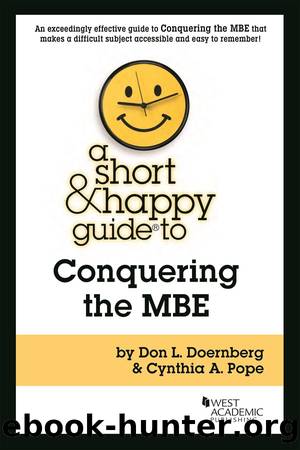A Short & Happy Guide to Conquering the MBE by Don L. Doernberg & Cynthia A Pope

Author:Don L. Doernberg & Cynthia A Pope
Language: eng
Format: epub
ISBN: 9781647088378
Publisher: West Academic Publishing
Published: 2021-10-15T00:00:00+00:00
Property
1.A and B purchased an apartment together as joint tenants with right of survivorship. They recorded the properly executed deed promptly. Several months later, A executed a deed for the apartment to C, forging Bâs name. C promptly recorded the deed. To whom does the apartment now belong?40
A.A and B as joint tenants with right of survivorship.
True or false: It still belongs to A and B as joint tenants with right of survivorship?
This alternative really says that no joint tenant acting unilaterally can affect title to property that is held in joint tenancy. At common law, that was true. Traditionally, a forged instrument was null. However, the modern rule recognizes âpartial validity,â where one party can convey the partyâs own interest. In this case, A could convey Aâs interest to C but could not convey Bâs interest. That means that A and B are no longer joint tenants. More than that, the conveyance destroys the joint tenancy, because joint tenancies must arise from a single transaction; the tenants cannot acquire their titles sequentially. This is not a candidate answer.
B.C and B as joint tenants with right of survivorship.
True or false: It belongs to C and B as joint tenants with right of survivorship?
This may be an appealing answer because one is apt to think that A has simply substituted C in Aâs place. Logically, that makes some sense. But, as Justice Holmes warned us long ago, âThe life of the law has not been logic: it has been experience.â This is not a candidate answer because the partial conveyance severed the joint tenancy and created a tenancy-in-common in its place. Joint 99
tenancies must arise at the same time from the same instrument; Câs and Bâs tenancies meet neither of these requirements.
C.C and B as tenants in common.
True or false: The apartment belongs to C and B as tenants in common?
This is a correct answer under the modern rule. Aâs conveyance of Aâs interest to C is valid. Obviously, Aâs fraudulent attempt to convey Bâs interest is not valid. So B and C now own the property. But how do they hold it? They cannot be joint tenants because their interests did not arise at the same time through a single conveyance. They cannot be tenants by the entirety for two reasons. First, as far as we know, they are not married, and that is a bit of a problem. (Being married is also sometimes a bit of a problem, but we digress.) Even if they got married after A and B divorced or A died, there would still be no tenancy by the entirety because their interests vested at different times through different instruments.
D.C in fee simple.
This is not a candidate answer under either the modern or the common-law rule. A could not transfer Bâs interest without Bâs consent, so A could not convey fee simple. Under the common-law approach, the instrument purporting to transfer title to C would have no effect whatsoever; A and B would remain joint tenants.41
Download
This site does not store any files on its server. We only index and link to content provided by other sites. Please contact the content providers to delete copyright contents if any and email us, we'll remove relevant links or contents immediately.
| Bar Examination | LSAT |
Master of the Game by Sidney Sheldon(2266)
GRE Premier 2017 with 6 Practice Tests by Kaplan(1835)
Law School Essays that Made a Difference by Princeton Review(1776)
Objection! by Nancy Grace(1762)
Law: A Very Short Introduction by Raymond Wacks(1715)
A Life of Crime by Harry Ognall(1710)
Philosophy of law a very short introduction by Raymond Wacks(1640)
College Essays that Made a Difference by Princeton Review(1625)
Examples & Explanations: Administrative Law by William F. Funk & Richard H. Seamon(1616)
Cracking the SAT Premium Edition with 6 Practice Tests, 2017 by Princeton Review(1565)
Writing to Win: The Legal Writer by Steven D. Stark(1559)
Civil Procedure (Aspen Casebooks) by Stephen C. Yeazell(1532)
GMAT For Dummies by Lisa Zimmer Hatch & Scott A. Hatch(1504)
Sidney Sheldon (1982) Master Of The Game by Sidney Sheldon(1495)
Drafting Contracts: How and Why Lawyers Do What They Do, Second Edition by Stark Tina L(1470)
Storytelling for Lawyers by Meyer Philip(1441)
So You Want to be a Lawyer by Lisa Fairchild Jones Esq(1395)
Graduate Admissions Essays, Fourth Edition: Write Your Way into the Graduate School of Your Choice by Donald Asher(1360)
Introduction to the study and practice of law in a nutshell by Kenney F. Hegland(1308)
